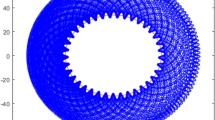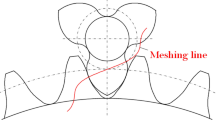Abstract
A simple and accurate numerical method was proposed for calculating the tooth profile of a noncircular gear. This method is directly based on the real gear shaping process, rather than deducing and solving complicated meshing equations used in the traditional method. The tooth profile is gradually obtained from the boundary produced by continuously plotting the cutter profile on the gear transverse plane. The key point of the method is picking up the graph boundaries. The relative position of the cutter profile on the gear transverse plane is determined by the given pitch line of the noncircular gear, parameters of the shaper cutter, and the shaping process data. In comparison with the traditional method, it is universal and is much more efficient and accurate, especially for noncircular gears, which have nontrivial pitch lines. Special problems in gear design and manufacturing, such as tooth pointing, undercut, and fillet interference, are included in the process. As an application example of the numerical method, a square internal gear is chosen from a new type of hydraulic motor with noncircular planetary gears, and the tooth profile of that gear is computed. The gear is successfully machined by electromagnetic discharge (EMD) using the resulting data.
Similar content being viewed by others
References
Bloomfield B (1960) When you need noncircular gears. Product Engineering, March 1960, 14:59–66
Cunningham FW, Cunningham DS (1973) Rediscovering the noncircular gear. Machine Design, November 1973, 1:79–86
Cunningham FW (1959) Noncircular gears. Machine Design, February 1959, 19:161–164
Dooner DB, Seireg AA (1995) The kinematic geometry of gearing. Wiley, New York, pp 56–63
King R (1972) Elliptical gears are back and more versatile than ever. Product Engineering, August 1972, pp 34–38
Ferguson RJ, Daws LF, Kerr JH (1975) The design of a stepless transmission using noncircular gears. Mechanism and Machine Theory, November 1975, 10:467–478
Kuczewski M (1988) Designing elliptical gears. Machine Design, April, 7:116–118
Tong S-H (1998) New conjugate pair design—theory and application. PhD dissertation, University of California, Los Angeles
Litvin FL (1994) Gear geometry and applied theory. Prentice-Hall, Englewood Cliffs, New Jersey
Chang SL, Tsay CB (1995) Mathematical model of the elliptical gear generated by shapers. J Chin Soc Mech Eng 16(5):415–423
Chang SL, Tsay CB, Wu LI (1996) Mathematical model and undercutting analysis of elliptical gears generated by rack cutters. Mech Mach Theory 31(7):879–890
Bair BW (2004) Computer aided design of elliptical gears with circular-arc teeth. Mech Mach Theory 39(2):153–168
Bair BW (2002) Computerized tooth profile generation of elliptical gears manufactured by shaper cutters. J Mater Process Technol 122(2):139–147
Author information
Authors and Affiliations
Corresponding author
Rights and permissions
About this article
Cite this article
Li, J., Wu, X. & Mao, S. Numerical computing method of noncircular gear tooth profiles generated by shaper cutters. Int J Adv Manuf Technol 33, 1098–1105 (2007). https://doi.org/10.1007/s00170-006-0560-0
Received:
Accepted:
Published:
Issue Date:
DOI: https://doi.org/10.1007/s00170-006-0560-0




